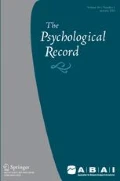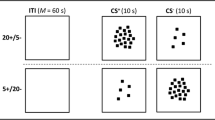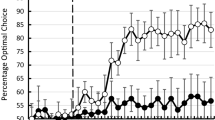Abstract
Previous attempts to condition a 1-celled organism, paramecium, by either classical or instrumental procedures, have yielded equivocal results. The present experiments were designed to determine whether the use of positive reinforcement provided by DC electrical stimulation at the cathode, which had previously been shown to be attractive to paramecia, could be used to train these organisms in a discrimination learning task. The results indicate that such learning did take place.
Similar content being viewed by others
References
APPLEWHITE, P. B. (1979). Learning in protozoa. In M. Levandowsky & S. H. Hunter (Eds.), Biochemistry and physiology of protozoa. New York: Academic Press.
APPLEWHITE, P. B., & GARDNER, E. T. (1973). Tube escape behavior of paramecia. Behavioral Biology, 9, 245–250.
ARMUS, H. L. & MONTGOMERY, A. R. (2001). Aversive and attractive properties of electrical stimulation for Paramecium caudatum. Psychological Reports, 89, 342–344.
BEST, J. B. (1954). The photosensitization of Paramecium Aurelia by temperature shock. Journal of Experimental Zoology, 126, 87–100.
BRAMSTEDT, F. (1935). Dressurversuche mit Paramecium caudatum und Stylonychia mytilus. (Training experiments with Paramecium caudatum and Stylonychia mytilus.) Zeitschrift für Vergleichende Physiologie, 22, 490–516.
CORNING, W. C., & VON BURG, R. (1973). Protozoa. In W. C. Corning, J. A. Dyal, & A. O. D. Willows (Eds.), Invertebrate learning. New York: Plenum Press.
DAY, L. M., & BENTLEY, M. (1911). A note on learning in Paramecium. Journal of Animal Behavior, 1, 67–73.
FRENCH, J. W. (1940). Trial and error learning in Paramecium. Journal of Experimental Psychology, 26, 609–613.
GELBER, B. (1952). Investigations of the behavior of Paramecium aurelia: I. Modification of behavior after training with reinforcement. Journal of Comparative and Physiological Psychology, 45, 58–65.
GELBER, B. (1956). Investigations of the behavior of Paramecium aurelia: III. The effect of the presence and absence of light on the occurrence of a response. Journal of Genetic Psychology, 88, 31–36.
GELBER, B. (1957). Food or training in the paramecium? Science, 126, 1340–1341.
GELBER, B. (1958). Retention in Paramecium aurelia. Journal of Comparative and Physiological Psychology, 51, 110–115.
GELBER, B. (1962a). Acquisition in Paramecium aurelia during spaced training. The Psychological Record, 12, 165–177.
GELBER, B. (1962b). Reminiscence and the trend of retention in Paramecium aurelia. The Psychological Record, 12, 179–192.
HANZEL, T. E., & RUCKER, W. (1971). Escape training in paramecia. Journal of Biological Psychology, 13, 24–28.
HENNESSEY, T. M., RUCKER, W. B., & McDIARMID, C. G. (1979). Classical conditioning in paramecia. Animal Learning and Behavior, 7, 417–423.
HUBER, J. C., RUCKER, W. B., & McDIARMID, C. G. (1974). Retention of escape training and activity changes in single paramecia. Journal of Comparative and Physiological Psychology, 86, 258–266.
JENSEN, D. D. (1957a). Experiments on “learning” in paramecia. Science, 125, 191–192.
JENSEN, D. D. (1957b). More on “learning” in paramecia. Science, 126, 1341–1342.
KATZ, M. S., & DETERLINE, W. A. (1958). Apparent learning in the paramecium. Journal of Comparative and Physiological Psychology, 51, 243–247.
MIRSKY, A. F., & KATZ, M. F. (1958). Avoidance “conditioning” in paramecia. Science, 127, 1498–1499.
SQONINA, K. (1939). Vergleichende Untersuchungen über die Sensibilisierung und bedingten Reflex (Comparative studies on sensitization and the conditioned reflex). Zeitschrift für Tierpsychologie, 3, 224–247.
SMITH, S. (1908). The limits of educability in paramecium. Journal of Comparative Neurology and Psychology, 18, 499–510
SOEST, H. (1937). Dressurversuche mit Ciliaten und Rhabdocoelen Turbellarien (Training experiments with ciliates and rhabdocoele turbellarians). Zeitschrift für vergleichende Physiologie, 24, 720–748
THORPE, W. H. (1963). Learning and instinct in animals. Cambridge, MA: Harvard University Press.
Author information
Authors and Affiliations
Rights and permissions
About this article
Cite this article
Armus, H.L., Montgomery, A.R. & Jellison, J.L. Discrimination Learning in Paramecia (P. caudatum). Psychol Rec 56, 489–498 (2006). https://doi.org/10.1007/BF03396029
Published:
Issue Date:
DOI: https://doi.org/10.1007/BF03396029




